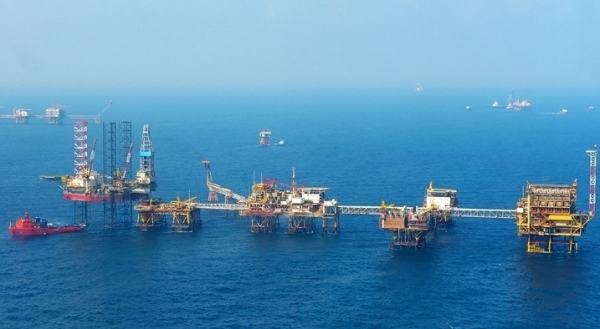Orientation for Petroleum Exploration and Extraction in the Near Future in Vietnam
What are the regulations on Orientation for Petroleum Exploration and Extraction in the Near Future in Vietnam? – Anh Duc (Long An)

Orientation for Petroleum Exploration and Extraction in the Near Future in Vietnam (Internet image)
The orientation for petroleum exploration and extraction in the near future is outlined in Decision 893/QD-TTg in 2023 on approval of the National Energy Master Plan for the period of 2021–2030 with a vision to 2050, issued by the Prime Minister.
Regarding the field of Petroleum Exploration, Extraction, the following directions are mentioned:
+ Direction:
++ Strengthen the basic survey and exploration of Petroleum within the country to increase reserves. Encourage major oil companies from countries with global standing to participate in exploration activities in deepwater, offshore, sensitive areas, and areas associated with the protection of national sovereignty over islands and seas.
++ Actively explore in shallow water areas, traditional areas, and conduct research on new exploration targets, new sedimentary basins, and unconventional hydrocarbons (tight reservoirs, coalbed methane, shale gas, hydrates, etc.) to supplement reserves for long-term exploitation.
++ For shale gas and hydrates (flammable ice), conduct in-depth geological research and apply advanced scientific and technological methods to expand the survey area. Initiate comprehensive evaluations and expedite pilot extraction when conditions permit.
++ Focus on exploration activities in the Cuu Long Basin, Nam Con Son Basin, Malay-Tho Chu Basin, and Song Hong Basin. Simultaneously, expand exploration and evaluate the potential for Petroleum extraction from unconventional targets. Continue exploration in deepwater and offshore areas such as the Phu Khanh Basin and Tu Chinh-Vung May Basin.
++ Conduct basic surveys and supplement exploration data in less-researched areas, transitional shallow water areas, in addition to continuing to conduct 2D seismic surveys with denser line grids. Study and evaluate the prospects of discovered structures, drill exploration wells in the most promising areas beyond 200m water depth and offshore.
++ Implement reprocessing or supplementary 2D/3D seismic data acquisition using new and advanced technologies to synchronize high-quality seismic data across the entire basin/region. Gradually carry out basic surveys and research on areas with potential hydrate gas in Nam Con Son and Tu Chinh-Vung May areas, as well as study the potential of unconventional Petroleum (tight reservoirs, coalbed methane, shale gas, hydrates, etc.) in the Song Hong, Cuu Long, and Nam Con Son basins.
++ Continue to conduct measurement surveys and collect seismic-geophysical data both in and outside the country to study the geological structures and evaluate the potential of Petroleum as well as hydrates in the Truong Sa - Hoang Sa Basin under favorable conditions.
++ Concentrate exploration activities in three key regions: the Southern Song Hong Basin, the central area of the Nam Con Son Basin, and the Cuu Long Basin.
++ Increase seismic data acquisition and reprocessing, especially in focal areas, to enhance resource potential.
+ Specific objectives:
++ In each 5–10-year cycle, conduct comprehensive assessments of the potential and reserves of Petroleum onshore and offshore Vietnam's continental shelf.
++ Increase reserves: Phase 2021-2030: 16–22 million tons of crude oil equivalent per year, recovery factor 0.9–1.1. Orientation for Phase 2031–2050: 16-27 million tons of crude oil equivalent per year, recovery factor 0.6–1.0.
- Number of deputy directors of departments in Vietnam in accordance with Decree 45/2025/ND-CP
- Cases ineligible for pardon in Vietnam in 2025
- Decree 50/2025 amending Decree 151/2017 on the management of public assets in Vietnam
- Circular 07/2025 amending Circular 02/2022 on the Law on Environmental Protection in Vietnam
- Adjustment to the organizational structure of the Ministry of Health of Vietnam: Certain agencies are no longer listed in the organizational structure
- Vietnam aims to welcome 22-23 million international tourists in Vietnam in 2025
-

- Number of deputy directors of departments in Vietnam ...
- 15:04, 05/03/2025
-

- Cases ineligible for pardon in Vietnam in 2025
- 14:43, 05/03/2025
-

- Decree 50/2025 amending Decree 151/2017 on the ...
- 12:00, 05/03/2025
-

- Circular 07/2025 amending Circular 02/2022 on ...
- 11:30, 05/03/2025
-

- Adjustment to the organizational structure of ...
- 10:34, 05/03/2025
-

- Notable new policies of Vietnam effective as of ...
- 16:26, 11/04/2025
-
.Medium.png)
- Notable documents of Vietnam in the previous week ...
- 16:21, 11/04/2025
-
.Medium.png)
- Notable documents of Vietnam in the previous week ...
- 16:11, 02/04/2025
-
.Medium.png)
- Notable new policies of Vietnam to be effective ...
- 16:04, 02/04/2025
-
.Medium.png)
- Notable new policies of Vietnam effective from ...
- 14:51, 21/03/2025

 Article table of contents
Article table of contents
